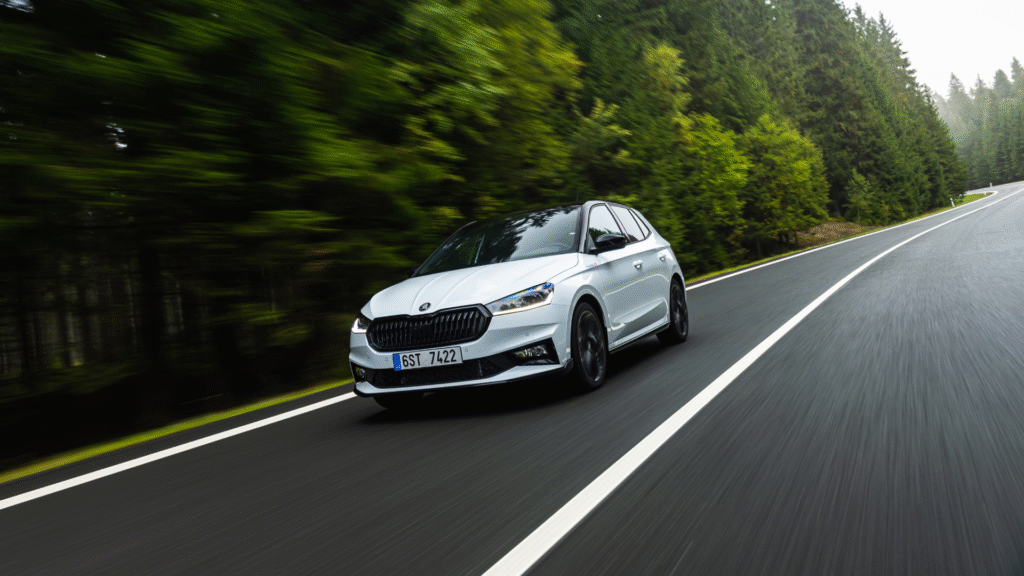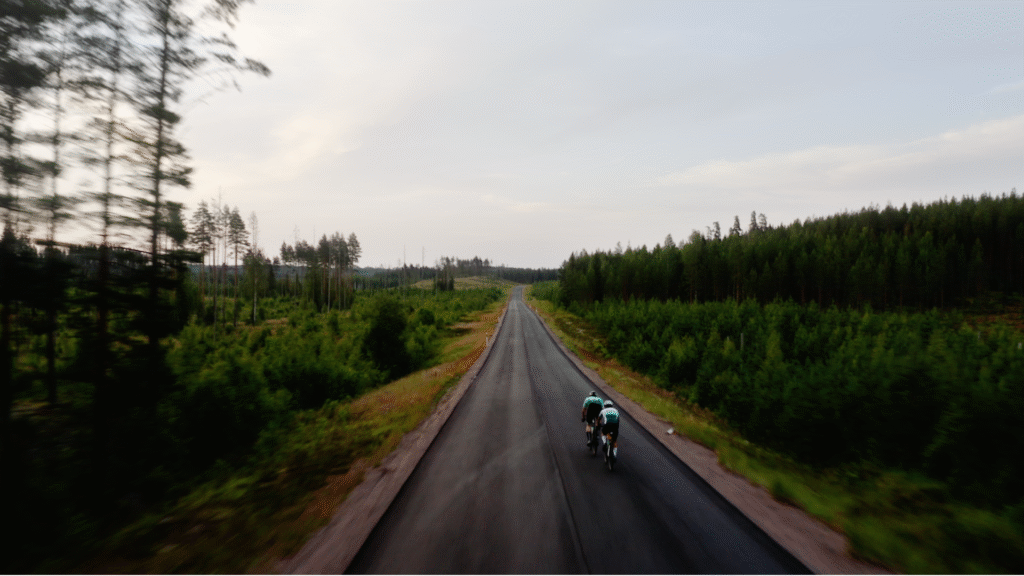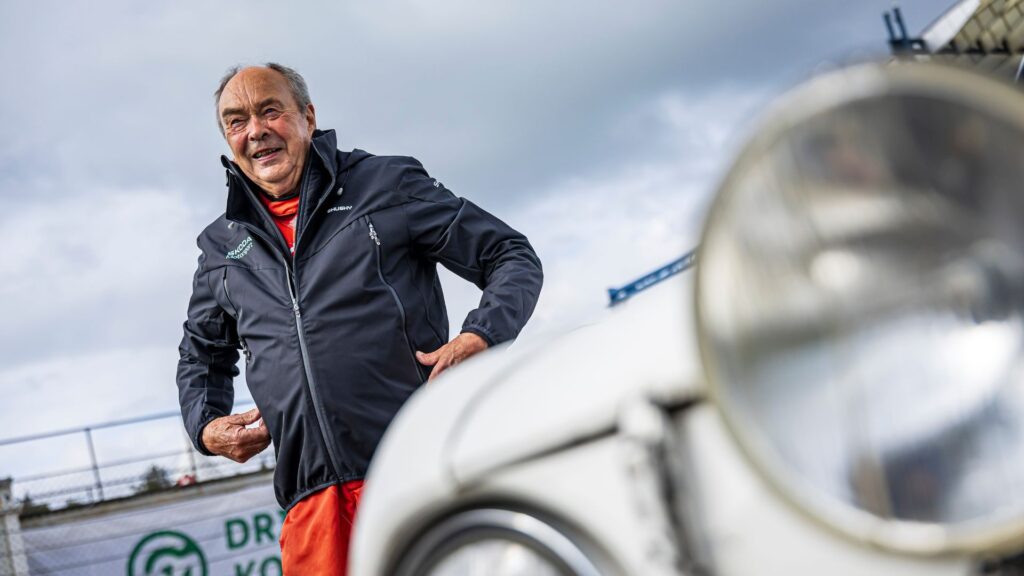When a poll was held in 2000 to determine the best driver of the century, stars like Sébastien Loeb, Carlos Sainz, Tommi Mäkinen or Colin McRae had to bow in front of a true great. We can argue which of his sporting achievements and what era of his career may be considered the most important, but there’s no doubt who is the greatest rally driver of all time. Both by poll results or simple facts, Walter Röhrl sure is one of the rally’s greatest drivers. Even literally, because he is 196 centimetres tall. And besides that, he is two times world champion and four time Rallye Monte Carlo winner.
The journey of Walter Röhrl, who was born in 1947 in Regensburg, to rallye, wasn’t easy and it almost ended even before it really started. His father wanted him to become a stonemason and when Walter’s older brother was killed in a car crash, he was quite persistent in his decision that the career of his youngest son will have nothing to do with driving, let alone motorsport.
Walter went on to study commerce in Bishop’s ordinariate in Regensburg and from the age of sixteen, he even worked for the bishop himself. He spent most of his free time skiing, rowing and playing ping-pong. He got qualified as skiing instructor and even won a local championship. His vast experience from the snowy slopes, including the work with moving the weight and balance, came handy later in his career.
And it was another coincidence that helped him pick the path that eventually led to glory. After he got his driving license, he started working for bishop’s company as a driver. He drove some 120,000 km a year, which allowed him to gain more valuable experience. Soon after that, in 1968, he got behind the wheel of a rally car for the first time. But a year before, something almost as important for his future life happened. He bought his first car, heeding the advice his older brother, an avid driving enthusiast and a Porsche 356 owner, gave him when Walter was 10: “When you become 18, wait until you are able to buy a really good car. Because the only good car is a Porsche”. Walter dutifully saved up his money and when he was 20, he bought a used Porsche 356C.
There, his lifelong love for the brand begun. From then, he always had a Porsche in his garage, his first 356 later replaced with a long line of 911s. In 1977, he achieved so good results with his personal Porsche 911, that he earned not just respect, but also a professional position in Fiat Abarth rally team. Even though Röhrl later raced cars of many different brands (Fiat, Ford, Opel, Lancia, Audi and BMW), he is tied to Porsche for life. At the height of his rally career, he participated in development of the hi-tech milestone of 1980s – the Porsche 959 supercar. And quarter a century ago, in 1993, he became a Porsche test driver and took part in creating many brands’ important cars, including many different 911s, Carrera GT, 918 Hybrid and Panamera.
Right from the start, he insisted that he will inform the chairman of the board about his findings, directly, regularly and “with no punches pulled”. And he keeps doing it until today. On the occasion of his 25thjob anniversary, Oliver Blume, the current Porsche boss, said: “Porsche owes Walter Röhrl not only for his loyalty of 25 years, but also for his quotes, many of which became classics. Like this one: A garage without a Porsche 911 is just a black hole.”
In 1968, though, the 21 year old skier and chauffeur had a long way to go before he’d be able to drive Porsches as “company cars”. His beginnings in rally were quite modest. That year, his friend Herbert Marecek offered Röhrl to enter Rally Bavaria with him as co-driver. Walter did not hesitate and jumped behind the wheel right away. He managed to fight his way into the top ten, before he was forced to retire due to technical problems. And by the way, his first rally car was Fiat 850 Coupé with breath-taking 47 horsepower, on road tyres. Even though it didn’t end with a success, the courageous performance of the young local driver was noticed by media. When asked where he learned to drive this well, he dryly replied that driving a racecar is similar to skiing.
A year later, he and Marecek managed to acquire much more competitive BMW 2002 Ti and went to Rally Bavaria once again. They finished second, but then the organizers found some irregularities on their car that were in violation with the rules, leading to their disqualification. In 1970, they tried a Porsche 911 on the same rally, once again unsuccessfully. For 1971 season, they took their preparation more seriously and entered nine events in Germany and one in France. They won Rudolf Diesel Rally and Rally Wiesbaden and they took their Ford Capri 2600 to two more victories, one third and one fourth position. Quite a success for a newcomer.
In 1972, Röhrl stayed faithful to his Capri, but he switched co-drivers. He entered just three European Rally Championship events, winning once, finishing second once and once retiring. The year of 1973 brought definitive change of co-driver. With Jochen Berger by his side, he drove Opels Ascona and Commodore in eleven rallies and won five of them. The Opel wasn’t a paragon of reliability, though, so they had to retire three times. Even so, Walter stayed loyal to the brand and in 1974, he won six events with Ascona. Although he retired from four events due to mechanical troubles and crashed once, he became the European champion.
For the 1975 season, the newly minted champion once again sat behind the wheel of an Ascona, but after two rallies, he replaced it with an Opel Kadett GT/E. In one race, the Kadett failed him when it developed driveshaft problems, and he retired once more. With Ascona, things were more interesting. Once, its electrics decided to die. Then, the engine or suspension failed. Overall, Röhrl finished just two races – finished fourth on Costa Brava and won the Rally Acropolis.
It wasn’t much better in 1976 season, even though it ended up with Röhrl securing 4thplace in ERC. He finished four events and one of them. In the remaining rallies, his Opel always found some reason to remain stationary by the side of the road. Once, it even ended up in a ditch, although that wasn’t fault of the machinery – it was Walter himself who sent it there during the transport stage.
In 1977, Röhrl apparently started losing patience with Opels. He entered eight rallies and finished only half of them. He alternated unlucky Kadetts with his personal Porsche 911 and three times, he tried a Fiat 131 Abarth. It turned out to be a perfect car for the driver who famously said that “Good rally drivers have dead flies on the side windows.”
The 1978 season saw Röhrl behind the wheel of Lancia Stratos HF in the German rallies, while in ERC, he competed with Fiat 131 Abarth. He won twice, which was enough for sixth place in driver’s championship. For the first time, his co-driver was Christian Geistdörfer, with whom he kept on racing until the end of the 1980s. In 1979, he took his Fiat to 9thplace overall in WRC, 11thin ERC and 10thin German championship.
For the 1980 season, Röhrl and Geistdörfer returned with Fiat 131 Abarth, this time with full factory support and entered twelve rallies. In Saalbach Röhrl retired, he finished fifth in Rally Acropolis, in France and New Zealand, he scored silver. And the remaining eight? Walter won all of them with ease and became the world champion after gaining 118 points. His dominance is perfectly illustrated by the fact that Hannu Mikkola finished second with 64 points. The breakthrough year also meant the end of driving for Fiat. Team manager Tony Fall couldn’t get over the fact that Röhrl refused to drive in RAC Rally (which he never liked) and the final straw was his refusal to shoot promotion video with the team’s main sponsor. As a strict non-smoker, Walter didn’t want to promote the Rothmans cigarettes, stating he was “hired as a driver, not an actor”.
After losing his ride with Fiat, he moved to his beloved Porsche. He entered both German championship and ERC with rally versions of 924 Carrera GTS and 911 SC, and he also tried his hand at track racing with 944 (which took his to the class victory at 24h Le Mans) and 935. Allegedly, Röhrl has never felt that any of his “company cars” had too much power – and that includes Group B rally cars. He used to say that “the car has enough power only when you want to get in it in the morning, but instead you start shaking, shut the door and run away”.The Porsche 935, nicknamed Moby Dick, was closest to this definition. He described it as one of the scariest machines he ever drove. And it’s not surprising, given that the racecar with 3.2 litre, twin-turbocharged flat-six engine producing up to 845 horsepower and weight of just 1,030 kg was able to reach top speed of 367 km/h at the Mulsanne straight in Le Mans and on soaking wet Silverstone, it spun the rear wheels even at speeds over 200 km/h. We will never know whether his underwear survived, but the fact is he won the six-hour endurance race at Silverstone.
After this intermezzo, Walter returned to rally, stating that crowds in the pits and on the track annoyed him. He always said that he doesn’t want to be a racer, just the best driver. And that he doesn’t race for titles or money, but for the joy of precision control of the vehicle. And for that, the “intimacy” of special stages is perfect.
For the next year, 1982, several teams offered him a ride. Walter decided to give Opel one more chance, as the large and heavy, 270 horsepower Ascona 400 saloon was well-suited to his style. Right in the first event of the championship, Rallye Monte Carlo, he has shown what he can do with the car. In the ascend to Col de Turini, spectators threw snow on the track and Röhrl with rear-wheel-drive Opel lost valuable seconds to Mikkola on more modern, 4×4 Audi Quattro. On the way down from the mountain pass, he had to catch up the lost time and drove like crazy. “I wouldn’t want to sit beside myself as a co-driver”, he later commented the experience. “Montemeister”, as he was nicknamed for winning the rally four times, just wouldn’t let the opportunity slip away. That was also true for the whole rest of the season, in which (now reliable) Ascona helped him big time. He won his second WRC title with 109 points, ahead of Michéle Mouton (97 pts) and Hannu Mikkola (70 pts) – both driving Audi Quattros.
Although he didn’t manage to defend his championship title, Röhrl considers 1983 to be the favourite one of his career. He immensely enjoyed it, because he spent the whole season behind the wheel of a car he later described as the best one he ever drove – the Lancia 037. The lightweight Group B car was powered by two-litre (later 2.1 litre), four-cylinder Abarth engine with around 280 horsepower (later up to 340 hp), mounted in front of the rear axle and powering the rear wheels through the non-syncromesh five-speed transmission. Many consider it to be the purest rally car of all time and Röhrl was spellbound by it, as he could enjoy driving in its cleanest form.
The Lancia team was primarily going after victory in constructor’s championship and they didn’t care much about driver scores. They went to great lengths to succeed, like using a “creative” interpretation of homologation rules. They allegedly circumvented the need of building 200-piece homologation series by presenting marshals with “first half” of the produced cars in one parking lot, then taking them to lunch and later showing them the “other half” – which was actually the first half, moved there over lunch. Is it true? We may never know. It’s been said that fans helped Lancia by throwing snow on the track in Monte Carlo, where Röhrl won. He was third in Portugal, second in France and he won both Rallye Acropolis and New Zealand. Still, Lancia had many problems to cope with, like Röhrl’s refusal to drive the fragile Lancia in Finland, because he didn’t like jumps. “If I wanted to fly, I would become a pilot”, he said and simply didn’t go.
This meant that Lancia really needed to win its home event, Rally San Remo. The main challenge there is dust and anyone who starts after the leading vehicle had problems with visibility, as the dust takes long to settle. The team came up with fake malfunction of the seatbelts that would delay them long enough for the dust clouds to clear, but the marshals found out quickly. The Lancia’s success thus lay on the Röhrl’s shoulders. “It was the best rally of my life. It was a dream”, says the driver even now. He won 33 out of 58 special stages and Lancia scored 1-2-3 result, securing the championship win. Röhrl ended the WRC season runner-up behind Hannu Mikkola. He finished the season with a small gig driving a zero car at Köln-Ahrweiler rally in Germany. That wouldn’t be that important, were it not for the fact that he drove an Audi Quattro S2, which foreshadowed the next step in his career.
He remained with Audi for the rest of his active career, in seasons 1984 to 1987. His debut season with the brand, 1984, was not a very lucky one, as his Audi Quattro A2 and Quattro Sport were not very reliable and Walter finished just four rallies, winning three of them – including another victory at Monte Carlo. In 1985, he was doing much better. He was “only” second in Monte Carlo, but he won the Austrian rally as well as San Remo (where he ended upside down the year before). This meant third place in the WRC, behind Salonen and Blomqvist
He only did two rallies in 1986, finishing second in Monte Carlo on Audi Quattro Sport E2 and retiring from Rally Portugal. Röhrl’s last rallying season was also the first after the Group B cancellation. He drove the rally version of Audi 200 Quattro and finished 11thin WRC. Still, Audi had some Group B cars in its warehouses – and they were perfectly good to race, except for the lack of FIA’s approval. They took them to USA and there, they put Walter Röhrl behind the wheel of one Sport Quattro S1 E2 and told him to drive up a hill. Fast. In 10 minutes, 47 seconds and 85 hundredths, he was on top of that hill. And Audi had – thanks to the ice calm driving of accurate German driver – not only the victory, but also first time under 11 minutes in the Pikes Peak hillclimb. A year later, Ari Vatanen won with his legendary “Climb Dance”, driving a Peugeot 405 Turbo 16. It’s not very well known that he only beat Röhrl by 25 hundredths of a second, which is almost nothing. To put the numbers in perspective, in 1984, Michéle Mouton was able to win with the time of 12:10.38.
In the late 1980s and early 1990s, Walter Röhrl occasionally driven an Audi V8 in DTM championship and won at Nürburgring in 1990. In 1989, he also won the 500 km Watkins Glen race in USA.
In 2007, Röhrl did a tour de force when he beat Michael Schumacher without either one of them knowing it. Walter was testing the new Porsche 911 GT2 (997 generation) and of course, he had some competitor’s products on hand as well, one of them a Ferrari 599. During his hot lap on Nordschleife, he encountered an identical car, just in black colour. Being a competitive man, he decided to smoke the other car. And, in the final part of the circuit, he succeeded, after the other car’s driver made a small mistake, giving Walter a chance to pass. From the track, Röhrl went straight to the nearby roads to cool down the Ferrari. The black car followed him to Nürburg and its vicinity. Then, on a crossroads, both cars stopped next to each other. And to Röhrl’s surprise, Michael Schumacher looker out of the car. “I just wanted to look who’s faster than me. Now I see it’s you. I’m okay with that”, he said. Walter, of course, shared the story with his colleagues in the pits. And however it may have seemed that Schumi took easily, according to people from Ferrari it wasn’t the case. They say that he came back furious and ordered mechanics to go through the car to the last nut and bolt – unable to cope with the fact that Röhrl, older by two generation, was able to “dust” him at his home turf.
Despite his illustrious career, Walter Röhrl is still very modest and, in person, very kind man. His favourite way to spend free time is still just riding around in the countryside where he grew up. “To be happy, I don’t need private helicopters, a Florida house or a yacht. I’m find with my motorcycle, a trip to a forest in Bavaria and some lunch money”, says the legend of the world rally. Over his career, Walter Röhrl entered 75 WRC events and won 14 – four times at Monte Carlo. Since 1991, he competes in various classic car rallies, mostly with Porsche cars. He wrote several books about driving, racing theories and memoirs








